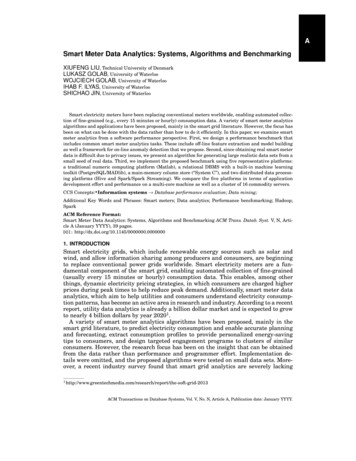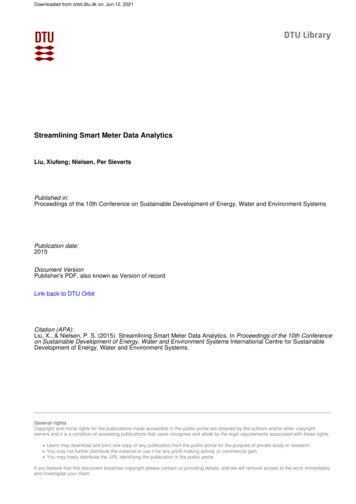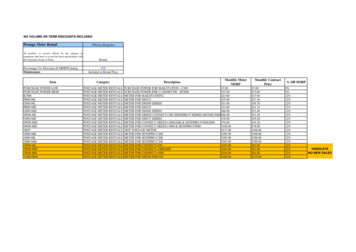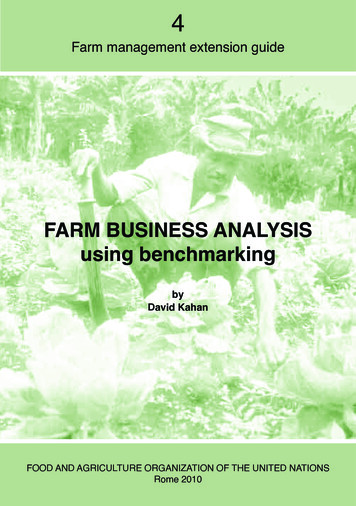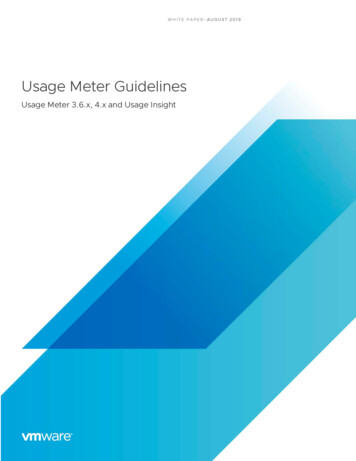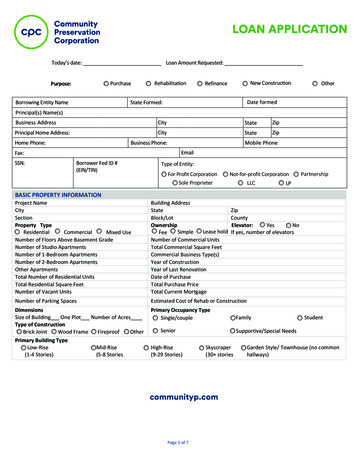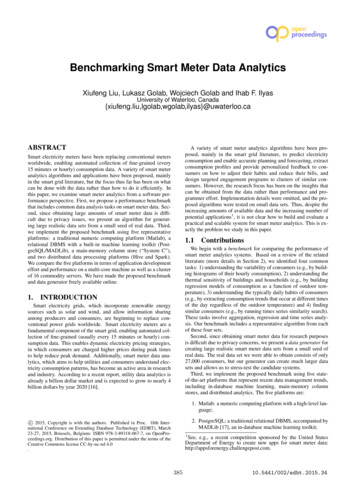
Transcription
Benchmarking Smart Meter Data AnalyticsXiufeng Liu, Lukasz Golab, Wojciech Golab and Ihab F. IlyasUniversity of Waterloo, caABSTRACTA variety of smart meter analytics algorithms have been proposed, mainly in the smart grid literature, to predict electricityconsumption and enable accurate planning and forecasting, extractconsumption profiles and provide personalized feedback to consumers on how to adjust their habits and reduce their bills, anddesign targeted engagement programs to clusters of similar consumers. However, the research focus has been on the insights thatcan be obtained from the data rather than performance and programmer effort. Implementation details were omitted, and the proposed algorithms were tested on small data sets. Thus, despite theincreasing amounts of available data and the increasing number ofpotential applications1 , it is not clear how to build and evaluate apractical and scalable system for smart meter analytics. This is exactly the problem we study in this paper.Smart electricity meters have been replacing conventional metersworldwide, enabling automated collection of fine-grained (every15 minutes or hourly) consumption data. A variety of smart meteranalytics algorithms and applications have been proposed, mainlyin the smart grid literature, but the focus thus far has been on whatcan be done with the data rather than how to do it efficiently. Inthis paper, we examine smart meter analytics from a software performance perspective. First, we propose a performance benchmarkthat includes common data analysis tasks on smart meter data. Second, since obtaining large amounts of smart meter data is difficult due to privacy issues, we present an algorithm for generating large realistic data sets from a small seed of real data. Third,we implement the proposed benchmark using five representativeplatforms: a traditional numeric computing platform (Matlab), arelational DBMS with a built-in machine learning toolkit (PostgreSQL/MADLib), a main-memory column store (“System C”),and two distributed data processing platforms (Hive and Spark).We compare the five platforms in terms of application developmenteffort and performance on a multi-core machine as well as a clusterof 16 commodity servers. We have made the proposed benchmarkand data generator freely available online.1.1.1ContributionsWe begin with a benchmark for comparing the performance ofsmart meter analytics systems. Based on a review of the relatedliterature (more details in Section 2), we identified four commontasks: 1) understanding the variability of consumers (e.g., by building histograms of their hourly consumption), 2) understanding thethermal sensitivity of buildings and households (e.g., by buildingregression models of consumption as a function of outdoor temperature), 3) understanding the typically daily habits of consumers(e.g., by extracting consumption trends that occur at different timesof the day regardless of the outdoor temperature) and 4) findingsimilar consumers (e.g., by running times series similarity search).These tasks involve aggregation, regression and time series analysis. Our benchmark includes a representative algorithm from eachof these four sets.Second, since obtaining smart meter data for research purposesis difficult due to privacy concerns, we present a data generator forcreating large realistic smart meter data sets from a small seed ofreal data. The real data set we were able to obtain consists of only27,000 consumers, but our generator can create much larger datasets and allows us to stress-test the candidate systems.Third, we implement the proposed benchmark using five stateof-the-art platforms that represent recent data management trends,including in-database machine learning, main-memory columnstores, and distributed analytics. The five platforms are:INTRODUCTIONSmart electricity grids, which incorporate renewable energysources such as solar and wind, and allow information sharingamong producers and consumers, are beginning to replace conventional power grids worldwide. Smart electricity meters are afundamental component of the smart grid, enabling automated collection of fine-grained (usually every 15 minutes or hourly) consumption data. This enables dynamic electricity pricing strategies,in which consumers are charged higher prices during peak timesto help reduce peak demand. Additionally, smart meter data analytics, which aims to help utilities and consumers understand electricity consumption patterns, has become an active area in researchand industry. According to a recent report, utility data analytics isalready a billion dollar market and is expected to grow to nearly 4billion dollars by year 2020 [16].1. Matlab: a numeric computing platform with a high-level language;2. PostgreSQL: a traditional relational DBMS, accompanied byMADLib [17], an in-database machine learning toolkit;c 2015, Copyright is with the authors. Published in Proc. 18th International Conference on Extending Database Technology (EDBT), March23-27, 2015, Brussels, Belgium: ISBN 978-3-89318-067-7, on OpenProceedings.org. Distribution of this paper is permitted under the terms of theCreative Commons license CC-by-nc-nd 4.0.1See, e.g., a recent competition sponsored by the United StatesDepartment of Energy to create new apps for smart meter 5441/002/edbt.2015.34
3. “System C”: a main-memory column-store commercial system (the licensing agreement does not allow us to reveal thename of this system);cooling load) and the temperature-insensitive component (other appliances). Thus, representative features include those which measure the effect of outdoor temperature on consumption [4, 10, 23]and those which identify consumers’ daily habits regardless of temperature [1, 8, 13], as well as those which measure the overall variability (e.g., consumption histograms) [3]. Our smart meter benchmark, which will be described in Section 3, includes four representative algorithms for characterizing consumption variability, temperate sensitivity, daily activity and similarity to other consumers.We also point out recent work on smart meter data quality(specifically, handling missing data) [18], symbolic representationof smart meter time series [27], and privacy (see, e.g., [2]). Theseimportant issues are orthogonal to smart meter analytics, which isthe focus of this paper.4. Spark [28]: a main-memory distributed data processing platform;5. Hive [25]: a distributed data warehouse system built on topof Hadoop, with an SQL-like interface.We report performance results on our real data set and larger realistic data sets created by our data generator. Our main finding isthat System C performs extremely well on our benchmark at thecost of the highest programmer effort: System C does not comewith built-in statistical and machine learning operators, which wehad to implement from scratch in a non-standard language. On theother hand, MADLib and Matlab make it easy to develop smart meter analytics applications, but they do not perform as well as System C. In cluster environments with very large data sizes, we foundHive easier to use than Spark and not much slower. Spark and Hiveare competitive with System C in terms of efficiency (throughputper server) for several of the workloads in our benchmark.Our benchmark (i.e., the data generator and thetested algorithms) is freely available for download athttps://github.com/xiufengliu. Due to privacy issues, we areunable to share the real data set or the large synthetic data setsbased upon it. However, a smart meter data set has recentlybecome available at the Irish Social Science Data Archive2 andmay be used along with our data generator to create large publiclyavailable data sets for benchmarking purposes.1.22.2Traditional options for implementing smart meter analytics include statistical and numeric computing platforms such as R andMatlab. As for relational database systems, two important technologies are main-memory databases, such as “System C” inour experiments, and in-database machine learning, e.g., PostgreSQL/MADLib [17]. Finally, a parallel data processing platformsuch as Hadoop or Spark is an interesting option for cluster environments. We have implemented the proposed benchmark in systemsfrom each of the above classes (details in Section 5).Smart meter analytics software is currently offered by severaldatabase vendors including SAP3 and Oracle/Data Raker4 , as wellas startups such as Autogrid.com, C3Energy.com and OPower.com.However, it is not clear what algorithms are implemented by thesesystems and how.There has also been some recent work on efficient retrieval ofsmart meter data stored in Hive [20], but that work focuses on simple operational queries rather than the deep analytics that we address in this paper.RoadmapThe remainder of this paper is organized as follows. Section 2summarizes the related work; Section 3 presents the smart meteranalytics benchmark; Section 4 discusses the data generator; Section 5 presents our experimental results; and Section 6 concludesthe paper with directions for future work.2.2.12.3RELATED WORKBenchmarking Data AnalyticsThere exist several database (e.g., TPC-C, TPC-H and TPC-DS)and big data5 benchmarks, but they focus mainly on the performance of relational queries (and/or transactions) and therefore arenot suitable for smart meter applications. Benchmarking time series data mining was discussed in [19]. Different implementationsof time series similarity search, clustering, classification and segmentation were evaluated. While some of these operations arerelevant to smart meter analytics, there are other important taskssuch as extracting consumption profiles that were not evaluated in[19]. Additionally, [19] evaluated standalone algorithms whereaswe evaluate data analytics platforms. Furthermore, [7] benchmarked data mining operations for power system analysis. However, its focus was on analyzing voltage measurements from powertransmission lines, not smart meter data, and therefore the testedalgorithms were different from ours. Finally, Arlitt et al. propose abenchmark for smart meter analytics that focuses on routine computations such as finding top customers and calculating monthlybills [9]. In contrast our work aims to discover more complex patterns in energy data. Their workload generator uses a Markov chainmodel that must be trained using a real data set.Smart Meter Data AnalyticsThere are two broad areas of research in smart meter data analytics: those which use whole-house consumption readings collectedby conventional smart meters (e.g., every hour) and those whichuse high-frequency consumption readings (e.g., one per second)obtained using specialized load-measuring hardware. We focus onthe former in this paper, as these are the data that are currently collected by utilities.For whole-house smart meter data feeds, there are two classes ofapplications: consumer and producer-oriented. Consumer-orientedapplications provide feedback to end-users on reducing electricityconsumption and saving money (see, e.g., [10, 21, 24]). Produceroriented applications are geared towards utilities, system operatorsand governments, and provide information about consumers suchas their daily habits for the purposes of load forecasting and clustering/segmentation (see, e.g., [1, 3, 5, 8, 12, 13, 14, 15, 22, 23]).From a technical standpoint, both of the above classes of applications perform two types of operations: extracting representativefeatures (see, e.g., [8, 10, 13, 14]) and finding similar consumersbased on the extracted features (see, e.g., [1, 12, 23, 24, 26]).Household electricity consumption can be broadly decomposedinto the temperature-sensitive component (i.e., the heating and2Systems and Platforms for Smart MeterData ssda/data/commissionforenergyregulationcer/386
3.Consump(on)(kWh))We also note that the TCP benchmarks include the ability to generate very large synthetic databases, and there has been some research on synthetic database generation (see, e.g., [11]), but we arenot aware of any previous work on generating realistic smart meterdata.THE BENCHMARKIn this section, we propose a performance benchmark for smartmeter analytics. The primary goal of the benchmark is to measurethe running time of a set of tasks that will be defined shortly. Theinput consists of n time series, each corresponding to one electricity consumer, in one or more text files. We assume that eachtime series contains hourly electricity consumption measurements(in kilowatt-hours, kWh) for a year, i.e., 365 24 8760 datapoints. For each consumption time series, we require an accompanying external temperature time series, also with hourly measurements.For each task, we measure the running time on the input data set,both with a cold start (working directly from the raw files) and awarm start (working with data loaded into physical memory). Inthis version of the benchmark, we do not consider the cost of updates, e.g., adding a day’s worth of new points to each time series.However, adding updates to the benchmark is an important direction for future work as read-optimized data structures that help improve running time may be expensive to update.Utility companies may have access to additional data about theircustomers, e.g., location, square footage of the home or family size.However, this information is usually not available to third-partyapplications. Thus, the input to our benchmark is limited to thesmart meter time series and publicly-available weather data.We now discuss the four analysis tasks included in the ))))35)External)temperature)(degrees)C))Figure 1: Example of the 3-line regression model.value and then computes the two sets of regression lines. In the finalstep, the algorithm ensures that the three lines are not discontinuousand therefore it may need to adjust the lines slightly.As shown in Figure 1, the 3-line algorithm extracts useful information for customer feedback. For instance, the slopes (gradients)of the left and right 90th percentile lines correspond to the heating and cooling sensitivity, respectively. A high cooling gradientmight indicate an inefficient air conditioning system or a low airconditioning set point. Additionally, the height at the lowest pointon the 10th percentile lines indicates base load, which is the electricity consumption of appliances and devices that are always onregardless of the temperature (e.g., a refrigerator, a dehumidifier,or a home security system).Consumption Histograms3.3The first task is to understand the variability of each consumer.To do this, we compute the distribution of hourly consumption foreach consumer via a histogram. The x-axis in the histogram denotes various hourly consumption ranges and the y-axis is the frequency, i.e., the number of hours in the year whose electricity consumption falls in the given range. For concreteness, in the proposedbenchmark we specify the histograms to be equi-width (rather thanequi-depth) and we always use ten buckets.3.2cooling)gradient)hea(ng)gradient)Daily ProfilesThe third task is to extract daily consumption trends that occurregardless of the outdoor temperature. For this, we use the periodicautoregression (PAR) algorithm for time series data from [8, 13].The idea behind this algorithm is illustrated in Figure 2. At the top,we show a fragment of the hourly consumption time series for someconsumer over a period of several days. We are only given the totalhourly consumption, but the goal of the algorithm is to determine,for each hour, how much load is temperature-independent and howmuch additional load is due to temperature (i.e., heating or cooling). Once this is determined, the algorithm computes the averagetemperature-independent consumption at each hour of the day, illustrated at the bottom of Figure 2. Thus, for each consumer, theoutput consists of a vector of 24 numbers, denoting the expectedconsumption at different hours of the day due solely to the occupants’ daily habits and not affected by temperature.For each consumer and each hour of the day, the PAR algorithmfits an auto-regressive model, which assumes that the electricityconsumption at that hour of the day is a linear combination of theconsumption at the same hour over the previous p days (we use p 3, as in [8]) and the outdoor temperature. Thus, it groups the inputdata set by consumer and by hour, and computes the coefficients ofthe auto-regressive model for each group.Thermal SensitivityThe second task is to understand the effect of outdoor temperature on the electricity consumption of each household. Thesimplest approach is to fit a least-squares regression line to theconsumption-temperature scatter plot. However, in climates with acold winter and warm summer, electricity consumption rises whenthe temperature drops in the winter (due to heating) and also riseswhen the temperature rises in the summer (due to air conditioning).Thus, a piecewise linear regression model is more appropriate.We selected the recently-proposed algorithm from [10] for thebenchmark, to which we refer as the 3-line algorithm. Consider aconsumption-temperature scatter plot for a single consumer shownin Figure 1 (the actual points are not shown, but a point on this plotwould correspond to a particular hourly consumption value and theoutdoor temperature at that hour). The upper three lines correspondto the piecewise regression lines computed only for the points inthe 90th percentile for each temperature value and the lower threelines are computed from the points in the 10th percentile for eachtemperature value. Thus, for each time series, the algorithm startsby computing the 10th and 90th percentiles for each temperature3.4Similarity SearchThe final task is to find groups of similar consumers. Customersegmentation is important to utilities so they can determine howmany distinct groups of customers there are and design targetedenergy-saving campaigns for each group. Rather than choosing387
Consump,on%(kWh)%benchmark with increasing values of n. Since it is difficult to obtain large amounts of smart meter data due to privacy issues, andsince using randomly-generated time series may not give accurateresults, we propose a data generator for realistic smart meter data.The intuition behind the data generator is as follows. Since electricity consumption depends on external temperature and daily activity, we start with a small seed of real data and we generate thedaily activity profiles (recall Figure 2) and temperature regressionlines (recall Figure 1) for each consumer therein. To generate anew time series, we take the daily activity pattern from a randomlyselected consumer in the real data set, the temperature dependencyfrom another randomly-selected consumer, and we add some whitenoise. Thus, we first disaggregate the consumption time series ofexisting consumers in the seed data set, and we then re-aggregatethe different pieces in a new way to create a new consumer. Thisgives us a realistic new consumer whose electricity usage combinesthe characteristics of multiple existing consumers.Figure 3 illustrates the proposed data generator. As a preprocessing step, we use the PAR algorithm from [13] to generatedaily profiles for each consumer in the seed data set. We then runthe k-means clustering algorithm (for some specified value of k,the number of clusters) to group consumers with similar daily profiles. We also run the 3-line algorithm and record the heating andcooling gradients for each consumer.Now, creating a new time series proceeds as follows. We randomly select an activity profile cluster and use the cluster centroidto obtain the hourly consumption values corresponding to daily activity load. Next, we randomly select an individual consumer fromthe chosen cluster and we obtain its cooling and heating gradients.We then need to input a temperature time series for the new consumer and we have all the information we need to create a newconsumption time series6 . Each hourly consumption measurementof the new time series is generated by adding together 1) the dailyactivity load for the given hour, 2) the temperature-dependent loadcomputed by multiplying the heating or cooling gradient by thegiven temperature value at that hour, and 3) a Gaussian white noisecomponent with some specified standard deviation 3%%Figure 2: Example of a daily profile.a specific clustering algorithm for the benchmark, we include amore general task: for each of the n time series given as input,we compute the top-k most similar time series (we use k 10).The similarity metric we use is cosine similarity. Let X and Y betwo time series. The cosine similarity between them is defined astheir dot product divided by the product of their vector lengths, i.e,X·Y. X Y 3.5DiscussionTo recap, the proposed benchmark consists of 1) the consumption histogram, 2) the 3-line algorithm for understanding the effect of external temperature on consumption, 3) the periodic autoregression (PAR) algorithm to extract typical daily profiles and 4)the time series similarity search to find similar consumers. The firstthree algorithms analyze the electricity consumption of each household in terms of its distribution, its temperature sensitivity and itsdaily patterns. The fourth algorithm finds similarities among different consumers. While many more smart meter analytics algorithmshave been proposed, we believe the four tasks we have chosen accurately represent a variety of fundamental computations that mightbe used to extract insights from smart meter data.In terms of computational complexity, the first three algorithmsperform the same task for each consumption time series and therefore can be parallelized easily, while similarity search has quadraticcomplexity with respect to the number of time series. Computing histograms requires grouping the time series according to consumption values. The 3-line algorithm additionally requires grouping the data by temperature, and requires statistical operators suchas quantiles and least-squares regression lines. The PAR and similarity algorithms require time series operations. Thus, the proposedbenchmark tests the ability to extract different segments of the dataand run various statistical and time series operations.4.5.EXPERIMENTAL RESULTSThis section presents our experimental results. We start with anoverview of the five platforms in which we implemented the proposed benchmark (Section 5.1) and a description of our experimental environment (Section 5.2). Section 5.3 then discusses our experimental findings using a single multi-core server, including theeffect of data layout and partitioning (Section 5.3.1), the relativecost of data loading versus query execution (Section 5.3.2), and theperformance of single-threaded and multi-threaded execution (Section 5.3.3 and 5.3.4, respectively). In Section 5.4, we investigate theperformance of Spark and Hive on a cluster of 16 worker nodes. Weconclude with a summary of lessons learned in Section 5.5.5.1Benchmark ImplementationWe first introduce the five platforms in which we implementedthe proposed benchmark. Whenever possible, we use native statistical functions or third-party libraries. Table 1 shows which functions were included in each platform and which we had to implement ourselves.The baseline system is Matlab, a traditional numeric and statistical computing platform that reads data directly from files. We useTHE DATA GENERATORRecall from Section 3 that the proposed benchmark requires ntime series as input, each corresponding to an electricity consumer.Testing the scalability of a system therefore requires running the6In our experiments, we used the temperature time series corresponding to the southern-Ontario city from which we obtained thereal data set.388
turn"new"synthe.c".me"series" " s""""ac.vity"load" "temperature""""dependent"load" "white"noise"Figure 3: Illustration of the proposed data generator.use the Apache Math library for regression, but we had to implement our own histogram, quantile and cosine similarity functions.We use the Hadoop Distributed File System (HDFS) as the underlying file system for Spark.Finally, we test another distributed platform, Hive [25], which isbuilt on top of Hadoop and includes a declarative SQL-like interface. Hive has a built-in histogram function, and we use ApacheMath for regression. We implemented the remaining functions(quantiles and cosine similarity) in Java as user-defined functions(UDFs). The data are stored in Hive external tables.In terms of programming time to implement our benchmark,PostgreSQL/MADLib required the least effort, followed by Matlab and Hive, while Spark and especially System C required by farthe most effort. In particular, we found Hive UDFs easier to writethan Spark programs. However, since we did not conduct a userstudy, these programmer effort observations should be treated asanecdotal.In the remainder of this section, we will refer to the five testedplatforms as Matlab, MADLib, C (or System C), Spark and Hive.Table 1: Statistical functions built into the five tested platformsFunctionMatlab MADLib System C ary libraryCosinenononononoSimilaritythe built-in histogram, quantile, regression and PAR functions, andwe implemented our own (very simple) cosine similarity functionby looping through each time series, computing its similarity to every other time series, and, for each time series, returning the top 10most similar matches.We also evaluate PostgreSQL 9.1 and MADLib version 1.4 [17],which is an open-source platform for in-database machine learning. As we will explain later in this section, we tested two ways ofstoring the data: one measurement per row, and one customer perrow with all the measurements for this customer stored in an array.Similarly to Matlab, everything we need except cosine similarityis built-in. We implemented the benchmark in PL/PG/SQL withembedded SQL, and we call the statistical functions directly fromwithin SQL queries. We use the default settings for PostgreSQL7 .Next, we use System C as an example of a state-of-the-art commercial system. It is a main-memory column store geared towardstime series data. System C maps tables to main memory to improveI/O efficiency. In particular, at loading time, all the files are memory mapped to speed up subsequent data access. However, SystemC does not include a machine learning toolkit, and therefore weimplemented all the required statistical operators as user-definedfunctions in the procedural language supported by it.We also use Spark [28] as an example of an opensource distributed data processing platform. Spark reports improved performance on machine learning tasks over standardHadoop/MapReduce due to better use of main memory [28]. We5.2Experimental EnvironmentWe run each of the four algorithms in the benchmark using eachof the five platforms discussed above, and measure the runningtimes and memory consumption. We use the following two testing environments. Our server has an Intel Core i7-4770 processor (3.40GHz,4 Cores, hyper-threading is enabled, two hyper-threads percore), 16GB RAM, and a Seagate hard drive (1TB, 6 GB/s,32 MB Cache and 7200 RPM), running Ubuntu 12.04 LTSwith 64bit Linux 3.11.0 kernel. PostgreSQL 9.1 is installedwith the settings “shared buffers 3072MB, temp buffers 256MB, work mem 1024MB, checkpoint segments 64"and default values for other configuration parameters. We also use a dedicated cluster with one administration nodeand 16 worker nodes. The administration node is the master node of Hadoop and HDFS, and clients submit jobsthere. All the nodes have the same configuration: dualsocket Intel(R) Xeon(R) CPU E5-2620 (2.10GHz, 6 coresper socket, and two hyper-threads per core), 60GB RAM,running 64bit Linux with kernel version 2.6.32. The nodes7We also experimented with turning off concurrency control andwrite-ahead-logging which are not needed in our application, butthe performance improvement was not significant.389
3025201510508.0MADlibCFigure 4: Data loading times,10GB real dataset.4.02.025201510T150.51.01.5Size of dataset, GB2.0Figure 5: Impact of data partitioningon analytics, 3-line algorithm.5.3.20T2T3MatlabMADlibCFigure 6: Cold-start vs. warm-start,3-line algorithm, 10GB real dataset.Cold Start vs. Warm StartNext, we measure the time it takes each system to load data intomain memory before executing the 3-line algorithm (we saw similar trends when testing other algorithms from the benchmark). Incold-start, we record the time to read the data from the underlying database or filesystem and run the algorithm. In warm-start,we first read the data into memory (e.g., into a Matlab array, or inPostgreSQL, we first run SELECT queries to extract the data weneed) and then we run the algorithm. Thus, the difference betweenthe cold-start and warm-start running times corresponds to the timeit takes to load the data into memory.Figure 6 shows the results on the real data set. The left barsindicate cold-start running times, whereas the right bars representwarm-start running times an
smart meter data stored in Hive [20], but that work focuses on sim-ple operational queries rather than the deep analytics that we ad-dress in this paper. 2.3 Benchmarking Data Analytics There exist several database (e.g., TPC-C, TPC-H and TPC-DS) and big data 5 benchmarks, but they focus mainly on the perfor-

